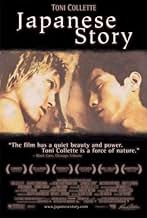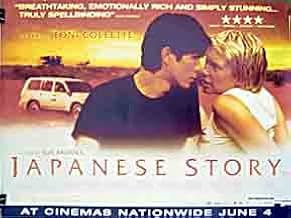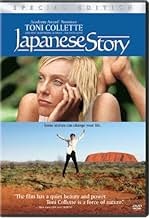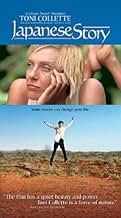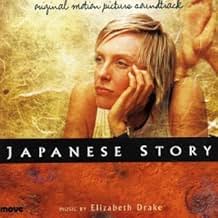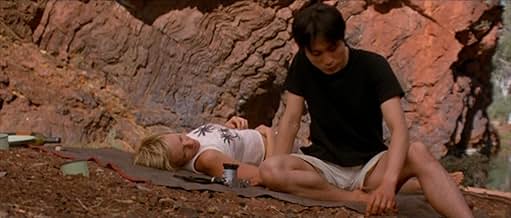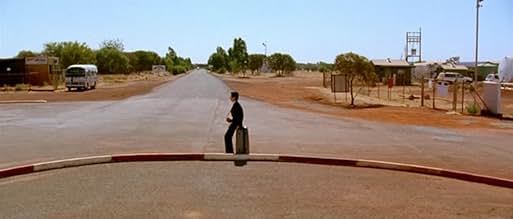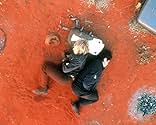Ajouter une intrigue dans votre langueAgainst the background of an Australian desert, Sandy, a geologist, and Hiromitsu, a Japanese businessman, play out a story of human inconsequence in the face of the blistering universe. The... Tout lireAgainst the background of an Australian desert, Sandy, a geologist, and Hiromitsu, a Japanese businessman, play out a story of human inconsequence in the face of the blistering universe. The end of the journey leaves no one capable of going back to where they started from.Against the background of an Australian desert, Sandy, a geologist, and Hiromitsu, a Japanese businessman, play out a story of human inconsequence in the face of the blistering universe. The end of the journey leaves no one capable of going back to where they started from.
- Réalisation
- Scénario
- Casting principal
- Récompenses
- 20 victoires et 13 nominations au total
- Canteen Worker
- (as Jules Hutchison)
Avis à la une
It may not be apparent immediately that you'd be experiencing an emotional ride. But I found the pace just right - right there in the outback environment with the two of them, day, night, very hot, shivering cold, sweating, digging. There's a certain atmosphere to the film - can't quite label it but definitely Australian geographical-oriented - land, nature and people. Thrown into the mix is the Japanese culture for added spice, thoughtfully put together. Hence the joy, jumping for joy, laughter, joking, gentleness, intimacy, we'd understand. The turn of events edifies how unexpected life can be - the yin and yang, the ecstasy and sadness, just at the change of a moment, a motion stunned, numb. The mystery of life and death is utterly incomprehensible by man. The focus is not on grief or state of shock, nor simply on cultural differences, the aim seems further: it almost culminates in the words about the joy given to him, the chance to appreciate the vastness of the space (desert), and being able to open his heart.
The two Japanese roles were well cast: Gotaro Tsunashima as Hiro performed pitch perfect. The role of the wife by Yumiko Tanaka, though brief, is important to complement Collette's role. Both gave just the right dose and tempo to the characters.
The Australian landscape is simple yet breathtaking. Cinematographer Ian Baker and film editor Jill Bicock are both from Australia and had worked together on "IQ" 1994 and "A Cry in the Dark" 1988. Music by Elizabeth Drake and casting by Dina Mann both are former collaborators with the team of Brooks, Tilson and producer Sue Maslin in 1997 ("Road to Nhill").
The film reminds me of w-d Friðriksson's "Cold Fever" (1995) and w-d Clara Law's "The Goddess of 1967" (2000). The former is a road movie of a young Japanese businessman traveling to Iceland to observe tradition and honor his dead parents; the latter is an Australian made film with outback landscapes and an intriguing non-conforming story.
Kudos to Alison Tilson who has written an insightful script, and Sue Brooks who has confidently directed this film made in "forty days and forty nights in the desert." Production by Gecko Films, Australia, and distribution by Samuel Goldwyn Films, U.S., "Japanese Story" is a thought-provoking film to experience.
Thanks to the summary line 'The less you know about this film, the better', I curbed my urge to find out more about this film before watching it, something that I'm often tempted to do. If I had known the full plot, I would have been deprived of the dramatic experience of fully empathising with the emotions of the characters.
As others have said, this film is in three parts, call it three acts if you like plays or three movements if you like concertos. The first part is rather cliché, even banal, perhaps by intention. The scene of being stuck in the sand with the wheels spinning feverishly but going nowhere does strike a chord with those of us who have had similar experiences, on sand as well as on snow. The second part starts to intrigue and has all the necessary build-up. It's the third and final part, however, that has given me a cinematic experience that I've never had before. 'Powerful' will be an understatement. 'Powerful' however is not a fair description, because the word conjures up an image of being hit by an abrupt emotional blow. It's not quite like that. There's a sustained drive of waves of emotions, layer after layer. I know I'm getting myself into a lot of trouble saying this, but I think that it needs a woman director to pull this off. It also needs an actress in the caliber of Toni Colette.
Can't finish without mentioning the music. There are in fact a lot of scenes with absolutely no sound, not even the ambiance noise of the vast outback. But when there is music, they're the best. One good example is the love-making scene. But that is soon dwarfed compared with the hauntingly beautiful piece of music that is the background, sometimes just noticeable, sometimes coming forth, throughout the last twenty minutes of the film. Essentially, it alternates between a simple phrase of 8 notes on a plucked instrument and a haunting soprano chorus, blending in perfectly with the mood of the film.
"Japanese Story" is a quirky tale about Sandy Edwards, Collette, an Australian geologist in her, I would guess, mid-thirties. She's ordered to squire about the son of a Japanese industrialist whose investment in a major project is dearly desired by her bosses. The young man, handicapped by a very poor grasp of English and virtually none of Australian, is played by Gotaro Tsunashima. He might be well known in his native country but he was a new screen presence for me.
Sandy takes him on a tour of an achingly eerie, desolate, windswept part of Western Australia. Must of the movie was filmed in the Pilbara Desert, still aborigine country.
Sandy and her charge encounter adventurous situations while, no surprise, a romance springs up. Why Sandy would be attracted to the younger gentleman is never explained and it really shouldn't have been. "Japanese Story" asks the viewer to simply accept that liaisons arise without any deep preliminary exposition of character.
I won't reveal the plot, somewhat unexpected, but fate insures that this affair doesn't proceed swimmingly. What makes the movie is Collette's superb and affecting acting. I cared about her while knowing relatively little about her character's past life other than she hasn't completely resolved mom-daughter issues.
Nothing in this film could impel me to ever wish to go to the Pilbara Desert but it does excite my desire to see Collette take on many more challenging roles. She has a strong future-I hope.
8/10. See it if it plays near you, rent it later if not. You won't be sorry.
The Australian outback is a harsher but beautiful landscape of blokes and sheilas than the Manhattan of "Sex and the City" but it brings into relief similar questions of expectations of guys and gals in life and sex.
Toni Colette's "Sandy" is one tough geologist required to guide Gotaro Tsunashima to his father's company's environment-destroying mining businesses. Each suspiciously views the other through narrow stereotypical lenses that block out the complexities of their real lives and potential.
They very gradually adapt to each other, opening each other up to new experiences in quite unexpected ways, even though their language and life communication is still limited. She is the shaggy, physical, confident one; he is the smooth, intellectual, diffident one. "Sandy" is aggressive in a way much more typical of males in U.S. movies, while "Tachibana" is redolent of the farm wife in "The Bridges of Madison County."
The third act is even more startling in its catharsis for "Sandy" as she finds inner strengths and vulnerabilities to deal with her responsibilities across the cultural chasm.
I've not been to the Pilbara, but I've been to places like it elsewhere in Australia, and they tend to have the effect of reminding you of the fragility of your existence. The Aborigines (represented here by only a gas station attendant) regarded themselves as belonging to the land and here you can see why. It's not clear what Tachibana Hiromitsu, the rich businessman's son, is looking for in the desert, but he certainly feels its power. Just why Sandy the tough female geologist comes to harbour tender feelings towards him is not evident either; perhaps it's the mothering instinct at work- he's not an adaptable kind of guy and perhaps she senses his vulnerability.
Apart from the firm refusal to turn this film into a romantic comedy, despite some `When Harry Met Sally' moments, there are several other things going for it. First there is Toni Collette's entirely convincing performance which overcomes some weaknesses in the storyline (and improbabilities in her character). She has a lot of ground to cover, from boredom to hilarity, from dislike to intimacy, and from terror to melancholy.
Second, the cinematography fully exploits the scenery without detracting from the story. Much of `Japanese Story' was filmed around Port Headland in the Pilbara, but it's not a tourist brochure. Third, even the minor parts are played with precision (eg John Howard as the BHP man and Yukimo Tanaka as Tachibana's wife). It's difficult to judge just how effective Gotaro Tsunashima is you'd need to be Japanese, I guess, and anyway the script is from an Australian, Alison Tilson. To my eyes he seems real enough, if we accept he's from a very privileged and sheltered background. It's interesting that Sandy seems to be the initiator of their intimacy (he doesn't resist!).
I think this film would hold up well anywhere. It has more than the usual emotional content for an Australian film, an intriguing and poignant story, good acting, and it's not too long. The admission price is also considerably cheaper than an air ticket to Port Headland.
Le saviez-vous
- GaffesWhen the QANTAS jet to Kyoto leaves, it is actually leaving from the Perth domestic airport. The international terminal, where it would really leave from, and the Darling Ranges to the east, are clearly visible in the background.
- Crédits fousOur thanks to the people of Nyamal, Ngarluma, Yinjibarndi, Bunjima and Nyiparli Nations.
- ConnexionsFeatured in Inside Japanese Story: an evening with the film-makers (2004)
- Bandes originalesABC News Theme
(1986)
Written by Tony Ansell (as T. Ansell) and Peter Wall (as P. Wall)
Published by ABC Music Publishing and
Kindly reproduced with the permission of the Australian Broadcasting Corporation
Meilleurs choix
- How long is Japanese Story?Alimenté par Alexa
Détails
- Date de sortie
- Pays d’origine
- Sites officiels
- Langues
- Aussi connu sous le nom de
- Японская история
- Lieux de tournage
- Sociétés de production
- Voir plus de crédits d'entreprise sur IMDbPro
Box-office
- Budget
- 5 740 000 $US (estimé)
- Montant brut aux États-Unis et au Canada
- 647 054 $US
- Week-end de sortie aux États-Unis et au Canada
- 23 962 $US
- 4 janv. 2004
- Montant brut mondial
- 4 098 613 $US
- Durée1 heure 46 minutes
- Couleur
- Mixage
- Rapport de forme
- 2.35 : 1
Contribuer à cette page








